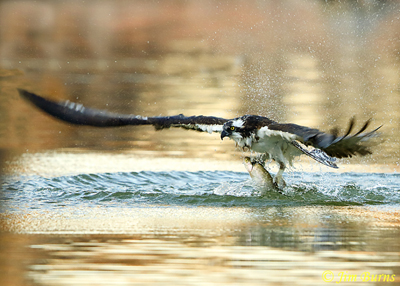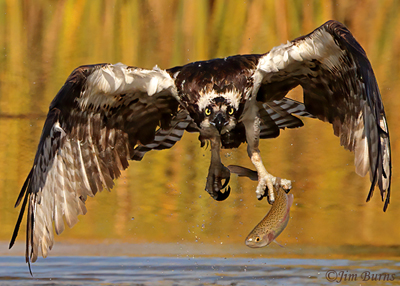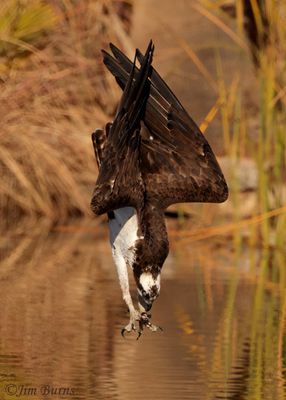Big Foot
March 9, 2023
If you’re not squeamish and you’re down with the circle-of-life aspect of avian natural history, if you get a thrill out of seeing a certain raptor doing its thing somewhere in the Valley almost any day during the winter, if you’re fascinated by the fact that raptor has the second most extensive worldwide distribution of all birds of prey, then the Osprey may just be your favorite bird.

Osprey Rising
Though the etymology of its common name, Osprey, is obscured in the shadows of history, we know Shakespeare mentioned avis praedae, this “bird of prey,” in Cariolanus—“As is the osprey to the fish, who takes it by sovereignty of nature.” Indeed fish comprise 99% of this common but beautiful raptor’s diet, and the Osprey’s “sovereignty of nature” over fish begins with the evolutionary modifications of its huge feet, uniquely adapted to haul slippery, wriggling prey from its watery habitat.

Huge Feet
Like woodpeckers and owls the Osprey’s outer toes are reversible, double-jointed if you will, and the feet themselves have spiny pads, an additional aid to grasping and carrying wet prey. If you study the photo clichés of Ospreys carrying, you’ll notice the talons and toes arrayed 2x2, equal gripping pressure on both sides of the fish, those needle-like talons as much as three inches long, rounded rather than grooved like other raptors’, and capable of being reticulated to form a net, a veritable network of needles.

2 X 2
Like athletes who perform wearing eye black, the dark feathering around Ospreys’ eyes reduces glare off the water as they patrol from above, often over 100 feet high, with eyesight six times more powerful than those athletes. Additionally these graceful predators can close their nostrils when they dive to keep water out, and the Osprey wing is both long and broad compared with other raptors, allowing for both effortless soaring flight and strong lifting ability.

Long and Broad
This high aspect wing ratio of Ospreys, however, does not preclude a breathtakingly swift dive when prey is spotted. Reconnaissance on the four to five foot wingspan comes first, then the rapid flapping that enables hovering as a sighting is assessed, and finally the folding of wings into the head first dive. The moment before the strike, the legs are extended allowing that network of needles to hit the water first. Typically only the talons and legs submerge but if the fish is too large, it may have to be released so the bird can escape the water. Very occasionally an Osprey will be unable to disengage its talons and succumb to drowning.

The Dive
Here in the Valley Osprey are so commonly seen from October through February that most birders, on their quest for the unusual, dismiss them as “just another Osprey,” missing opportunities to observe the spectacular aerobatics and innate instincts of these special raptors. Liftoff is always into the wind, fish are always carried in the same way, head forward to reduce drag, and one foot forward on the prey’s body, the other farther back. Many fishermen at local ponds tell me the birds somehow “know” when stocking takes place and always show up in greater numbers in the following days.

Close Up
Around the world the Osprey is known by many regional names for predacious birds that reference eagles and hawks. Birders thus assume the Seattle Seahawk logo is a stylized Osprey but, truth be told, it is based on the transformation masks of the Kwakwaka’wakw, an indigenous people of the Pacific Northwest coast. You may consider it an appreciative tribute to native totemic artwork or an unauthorized appropriation, but it does not depict an Osprey. The original mask design represented one of the fish-eating sea eagles and, when worn at tribal dances, opened to reveal a human face. These indigenous peoples understood the various Pacific coast avian predators better than we assume.
It is not often that even avid birders today have a chance to witness that circle of life first hand. A visit to your local Valley fishing pond between October and February may be your best chance to see Ospreys in action doing what they have evolved to do. Linger awhile and enjoy the show, and know if you witness a successful strike it only happens one in four tries. It’s not every day you’ll get to see evolution in action.